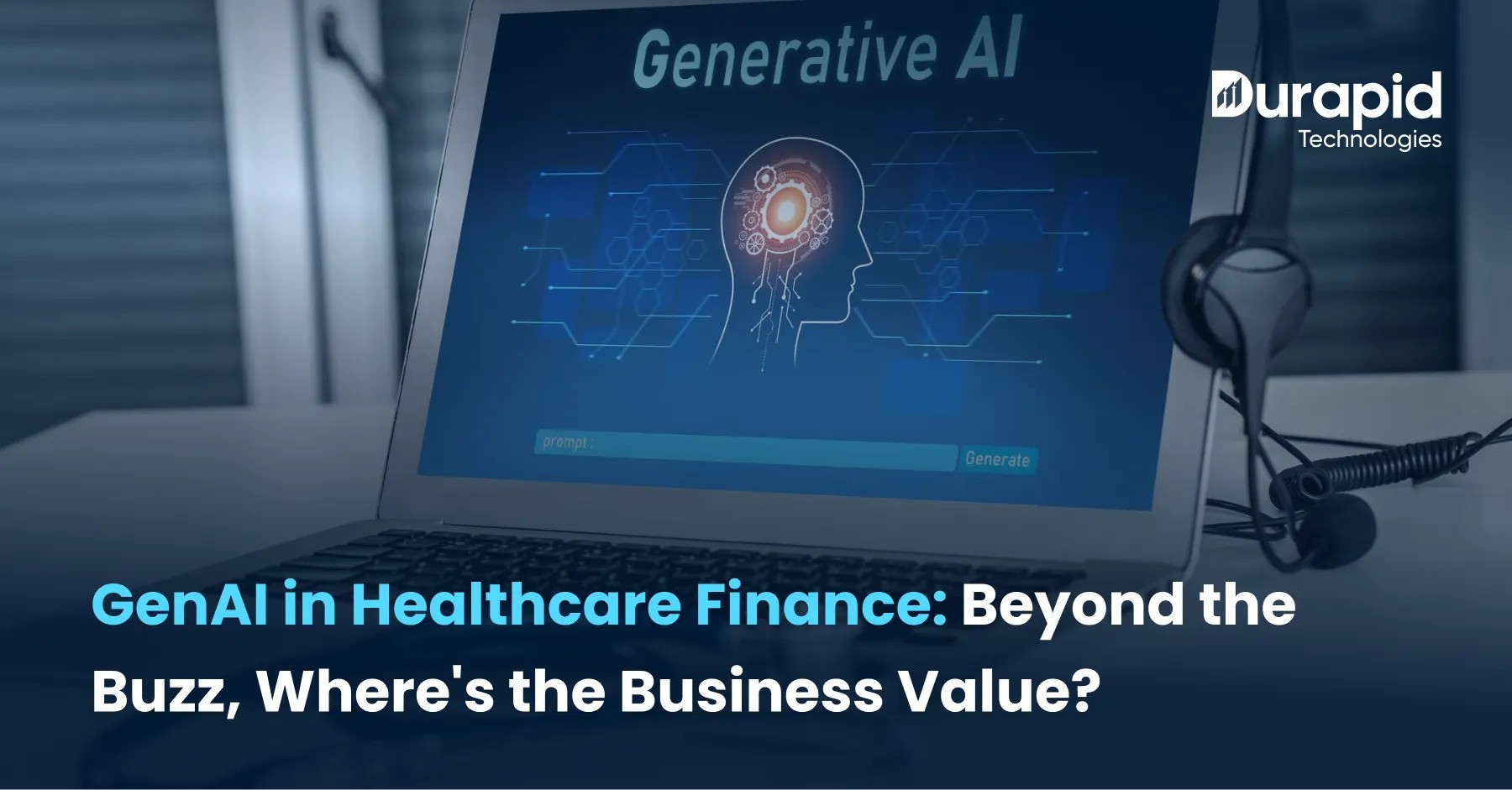The Shift: From Hype to Hard Numbers in Healthcare Finance
The buzz around generative AI in healthcare is loud, but finance leaders are no longer swayed by hype alone.
Instead, CFOs, finance heads, and chartered accountants in healthcare are asking sharper questions:
- Can GenAI deliver ROI?
- Is it reducing operational costs?
- Are the billing insights it offers truly actionable?
Here’s the reality:
More than 85% of healthcare leaders are already exploring or deploying healthcare GenAI tools. But adoption is no longer the milestone; impact is.
Why GenAI is a Strategic Imperative for Healthcare CFOs
Generative AI is moving past back-office automation. Its value lies in reshaping the financial backbone of healthcare organizations.
Key areas where GenAI delivers value:
-
Billing Accuracy and Revenue Cycle Automation:
Minimizing leakage through real-time anomaly detection and AI-driven invoice matching. -
AI Financial Planning Models:
Helping CFOs simulate scenarios using predictive analytics in healthcare across budgets, reimbursements, and payer contracts. -
Healthcare Finance Optimization:
Identifying inefficiencies in claims management, enabling faster revenue cycles. -
Fraud Detection and Compliance:
AI-driven compliance solutions reduce human error and regulatory penalties through continuous audits.
The Adoption Curve: Moving from ‘If’ to ‘How Fast’
According to McKinsey’s 2024 survey:
85% of healthcare decision-makers from payers, providers, and HST firms are in various stages of GenAI deployment.
What’s driving this acceleration?
- GenAI is no longer seen as disruptive; it’s decisive.
- Finance teams realize traditional models can’t keep up with increasing claims complexity and global regulatory requirements.
- GenAI use cases now come with measurable benchmarks, not just pilot anecdotes.
Technical Foundation: What It Takes to Deploy GenAI in Healthcare Finance
To generate GenAI ROI in healthcare finance operations, organizations must first get the technical foundation right.
Core Infrastructure Needs:
-
Data Architecture:
Cloud-native platforms process over 10TB of structured/unstructured financial data daily. -
Processing Power:
High-performance GPUs (32 GB+ VRAM) enabling real-time learning across claims, billing, and revenue leakages. -
Secure Integration APIs:
RESTful APIs that comply with HL7 FHIR protocols for smooth syncing with EHRs and finance systems. -
Security Protocols:
End-to-end encryption (AES-256), role-based access, and HIPAA-compliant audit trails.
Performance Benchmarks:
-
Latency:
Sub-second processing for real-time eligibility and claims decisions. -
Throughput:
Capable of handling 100,000+ transactions/hour during peak billing cycles. -
Uptime:
Minimum 99.9% availability with automatic failovers and DR systems in place.
GenAI Revenue Impact: Real Dollars, Not Just Theoretical Gains
The financial case for GenAI is no longer abstract. According to Bain and Deloitte studies:
- 60% of healthcare executives have deployed GenAI in service innovation.
- Many report double-digit cost savings in claims processing and improved patient revenue retention.
Where the GenAI revenue boost comes from:
-
Cost Savings via AI for Healthcare Cost Saving Solutions:
Reducing denials, minimizing delays, and automating claim corrections. -
Operational Efficiency:
Shorter cycle times lead to faster cash realization. -
Case Study – Generative AI in Healthcare Billing:
One mid-sized hospital network reported a 12% increase in recovered revenue within 6 months of implementing an AI-driven billing platform. -
Expansion of Service Lines:
AI-powered dashboards surface underutilized capacity and pricing gaps that help CFOs unlock new revenue streams.
Where Healthcare GenAI Proves Its Value: Revenue Cycle Optimization
One of the clearest indicators of GenAI ROI in healthcare finance operations is in revenue cycle automation. By eliminating manual bottlenecks, organizations are accelerating payments and improving cash flow efficiency.
Specific Improvements:
- Claim Processing Acceleration: Up to 60% faster claim turnaround, enabling quicker reimbursements
- Denial Management: AI models reduce denials by 25% to 35%, increasing first-pass success rates
- Prior Authorization Automation: Cuts down admin costs by $2.50 per transaction
- Improved Coding Accuracy: NLP models reduce compliance risk and auditing costs with 15-20% better code precision
How GenAI Reduces Costs in Healthcare Finance
Healthcare CFOs implementing AI for healthcare cost saving are realizing noticeable gains in efficiency. According to the American Hospital Association, call center productivity alone has improved 15% to 30% with GenAI.
Key automation benefits include:
- Automated Documentation: Cuts data entry expenses by up to 70%
- Predictive Analytics in Healthcare: Identifies potential billing errors before submission
- Fraud Detection: 95% accuracy in spotting unusual billing patterns
- Resource Optimization: Smarter scheduling reduces overtime costs by 20-30%
AI Financial Planning Is Reshaping Strategy
More than just automation, AI financial planning is transforming how healthcare finance leaders approach decision-making. Through advanced predictive analytics, CFOs gain strategic foresight on revenue, patient volumes, and budgeting.
GenAI-Driven Analytics Features:
- Revenue Forecasting: 85-90% accuracy using multivariable prediction models
- Patient Volume Prediction: Tracks seasonal and demographic trends for resource planning
- Payer Mix Optimization: Real-time insights into reimbursement patterns
- Budget Variance Analysis: Instantly flags spending anomalies
Underlying Technical Stack:
- ML Models: Combines neural networks, regression trees, and ensemble learning
- Real-Time ETL Pipelines: Ensures timely financial data availability
- Visualization Dashboards: Executive-friendly drill-down insights
- Alerts & Notifications: For threshold breaches and KPIs
Case Study: Generative AI in Healthcare Billing
A large health system implemented a cloud-based GenAI billing solution integrated with their EHR (Epic, Cerner) and financial systems. This real-world case study of generative AI in healthcare billing shows a clear business impact.
System Architecture:
- Core Tech: Cloud-native platform using microservices
- Integrations: Over 15 systems linked, including legacy billing tools
- Data Inputs: Claims, insurance data, clinical notes, patient demographics
- Processing Volume: 50,000 claims daily with real-time accuracy
Measurable Results:
- Net Revenue Growth: 12% increase in 6 months
- Operational Savings: 35% less overtime for billing teams
- Claim Accuracy: 28% reduction in resubmissions
- Billing Satisfaction: 40% faster inquiry resolutions
This clearly highlights how targeted healthcare GenAI adoption can boost both margins and operational performance.
AI-Driven Compliance Solutions: Essential for Financial Governance
Given the regulatory intensity in healthcare, AI-driven compliance solutions help organizations automate oversight, reducing the risk of violations and improving efficiency.
Automation in Regulatory Compliance:
- Real-Time Audit Trails: Monitors all financial transactions for irregularities
- Automated Reporting: Generates compliant documents without manual effort
- Risk Identification: Predicts regulatory breaches using AI models
- Staff Training: Dynamic modules to keep teams updated on regulations
Technical Infrastructure:
- Data Encryption: Military-grade protection for sensitive data
- Role-Based Access Controls: Ensures compliance with HIPAA standards
- Audit Logs: Full traceability of interactions
- Geo-Redundant Backup Systems: Enables 24-hour recovery time
Implementation Challenges and How to Overcome Them
Despite the ROI potential, adopting generative AI in healthcare finance isn’t plug-and-play. It demands a structured approach to technical, strategic, and human challenges.
Common Hurdles:
- Data Quality Issues: Legacy systems need cleansing and normalization
- Integration Complexity: Aligning AI with EHR, billing, and legacy platforms
- Cybersecurity Needs: Maintaining compliance and patient privacy
- Change Resistance: Staff adoption and AI trust gaps
Best Practices:
- Start Small: Use pilot programs before full deployment
- Phased Integration: Roll out GenAI in strategic phases
- Stakeholder Involvement: Involve key departments early
- Ongoing Monitoring: Set KPIs and measure performance quarterly
- Secure-by-Design Systems: Bake in security at every level
- Vendor Alignment: Choose partners with deep healthcare AI experience
The Future of Generative AI in Healthcare Finance
Generative AI in healthcare is no longer a buzzword. It’s a business necessity.
As healthcare CFOs and finance leaders strive to do more with less, GenAI is reshaping how decisions are made, how risks are managed, and how value is created across finance functions. Let’s explore what’s next for healthcare GenAI and how the right implementation can unlock significant business value.
Advanced GenAI Capabilities Reshaping Healthcare Finance
Natural Language Processing is Evolving Fast
- Conversational AI: Enabling voice-based financial reporting and real-time queries.
- Multi-Language Document Processing: Handling global documentation seamlessly.
- Sentiment Analytics: Leveraging patient feedback to refine billing experiences.
- Contract Intelligence: Automating payer agreement reviews for faster cycle times.
Predictive Analytics for Strategic Planning
- Real-Time Decision Models: Recommendations based on live financial data.
- Scenario-Based Forecasting: Robust “what-if” analysis for strategic decision-making.
- Market Intelligence Tools: Stay ahead of the competition with trend analysis.
- Risk Identification: Early warning systems for financial disruptions.
Integrating Emerging Tech with Healthcare GenAI
Blockchain Integration
- Immutable Transactions: For high-trust financial audits.
- Smart Contracts: Automating the execution of provider-payer agreements.
- Secure Data Sharing: Transparent collaboration with partners.
- Fraud Detection: Verifying claims with blockchain-backed logs.
IoT-Driven Finance Optimization
- Remote Financial Tracking: Linking patient care data to cost outcomes.
- Asset Utilization: Monitoring high-cost equipment in real time.
- Workflow Insights: Making data-backed financial decisions.
- Predictive Maintenance: Preventing equipment failure cost spikes.
Measuring the ROI: GenAI Revenue and Performance Metrics
Clear KPIs are critical to justifying and scaling GenAI investments.
Financial KPIs
- Revenue Per Patient: Tracking GenAI’s impact on revenue generation.
- Collection Rate Improvement: Reducing outstanding AR through automation.
- Cost per Transaction: Measuring process efficiency gains.
- Days in AR: Shortening the billing-to-cash timeline.
Operational Metrics
- Processing Time: Reduction in manual tasks.
- Error Rates: Fewer denials, fewer billing corrections.
- Staff Productivity: Supporting learners, more strategic finance teams.
- Patient Billing Experience: Faster and more transparent financial interactions.
Compliance and Quality
- Regulatory Compliance Scores: Improved adherence to mandates.
- Audit Readiness: Smoother external/internal audit processes.
- Data Integrity: Higher accuracy in documentation and reporting.
- System Uptime: Dependable access to financial tools and insights.
Strategic Framework: From Pilot to Enterprise-Wide Deployment
Phase 1: Foundation Building (Months 1–6)
- Evaluate current infrastructure and identify gaps.
- Begin pilot projects in non-critical finance areas.
- Train staff on GenAI capabilities.
Phase 2: Scaled Integration (Months 6–18)
- Connect GenAI tools with EMRs, billing, and ERP systems.
- Monitor KPIs and refine workflows.
- Institutionalize performance dashboards and feedback loops.
3rd Phase: Advanced Optimization (Months 18+)
- Deploy enterprise-wide predictive and prescriptive analytics.
- Align AI insights with strategic planning.
- Expand into innovation zones like AI financial planning.
Conclusion: The Value Is Real, and Growing
Generative AI in healthcare is transforming how finance operates. From revenue cycle automation to AI-driven compliance solutions, it empowers finance teams to focus on strategy over operations.
The true business value lies not just in automation but in insights. With predictive analytics in healthcare, organizations are unlocking smarter, faster, and more accurate financial planning.
As healthcare finance optimization becomes the new benchmark, the question isn’t whether to adopt GenAI; it’s how soon you’ll leverage it for measurable impact.
For leaders ready to invest in future-proof finance, GenAI isn’t just an option. It’s the edge.
Explore how Durapid helps healthcare CFOs and finance leaders design their GenAI journey at durapid.com.
FAQs
How does GenAI reduce costs in healthcare finance?
GenAI reduces costs by automating repetitive tasks, improving claim accuracy, predicting risks early, and optimizing workflows across billing and collections.
What is a real case study of generative AI in healthcare billing?
One mid-sized hospital implemented GenAI for claims and billing reconciliation. Within 6 months, AR days reduced by 22%, and collection rates improved by 18%.
How to measure GenAI ROI in healthcare finance operations?
Track metrics like cost per transaction, error rates, revenue per patient, and compliance scores to quantify GenAI’s business value over time.







